Finding Your Perfect Fit: A Comprehensive Guide to Women's Hiking Shoes
2025-06-02

Stepping onto a trail unlocks breathtaking landscapes and a profound sense of connection with nature. But no adventure is truly enjoyable without the right gear, starting with your foundation – your shoes. Choosing the best women's hiking shoes isn't just about style; it's about comfort, safety, performance, and ultimately, enhancing your outdoor experience. With countless options flooding the market, understanding key factors is essential to find your ideal pair.
Why Specific Women's Hiking Shoes Matter
Women's feet aren't simply scaled-down versions of men's. They tend to have a narrower heel, wider forefoot relative to overall shoe size, and a different arch structure. Dedicated women's hiking shoes are engineered with these anatomical differences in mind. A better-fitting shoe prevents blisters, hot spots, and instability on uneven terrain, reducing fatigue and increasing confidence mile after mile. Ignoring these differences can lead to discomfort that quickly overshadows the joy of hiking.
Key Features to Prioritize in Women's Hiking Shoes
1. Fit and Comfort: This is non-negotiable. Your heel should be securely locked without slippage, your toes should have ample wiggle room (especially downhill), and there should be no significant pressure points. Always try shoes after hiking or at the end of the day when feet are slightly swollen. Walk around the store on an incline if possible.
2. Support and Stability: Look for adequate arch support matching your foot type (neutral, low, or high arches). A sturdy midsole and good torsional rigidity help prevent ankle roll on rocky trails and reduce leg fatigue. Stability features vary between lightweight trail runners and heavier boots.
3. Traction: A grippy, durable outsole is vital for confidence on diverse terrain – wet rocks, loose scree, muddy paths. Vibram® soles are renowned, but other high-quality rubber compounds exist. Consider lug pattern (depth and spacing) for the types of trails you frequent.
4. Waterproofing vs. Breathability: This is a crucial trade-off:
Waterproof (e.g., Gore-Tex®): Essential for consistently wet, muddy, or cold conditions; keeps feet dry from external moisture. Ideal for shoulder seasons, marshland, or unpredictable weather. Can be less breathable, potentially leading to sweaty feet in hot weather.
Non-Waterproof (Breathable): Excellent for summer hiking, dry climates, or when you prioritize cooling airflow. They dry faster if they get wet. Perfect for established trails in warm weather.
5. Weight: Technology has revolutionized hiking footwear. Lighter women's hiking shoes reduce leg fatigue on long treks and technical terrain. Trail runners (often under 2 lbs/pair) are popular for speed and comfort on well-maintained trails. Mid-weight shoes offer a balance, while heavier boots provide maximum support for heavy backpacks or challenging, uneven ground.
6. Durability: Look for reinforced toe caps and heel counters to protect against rocks and roots, and high-quality materials for the upper (like synthetic leather or durable mesh). The sole should withstand abrasive surfaces.
7. Protection: A rock plate integrated into the midsole shields the soles of your feet from sharp rocks and roots. This is particularly beneficial on technical trails.
Matching the Shoe to Your Hike and Load
Day Hiking & Light Trails: Low-cut trail runners or light hiking shoes offer agility and comfort, ideal for well-maintained paths and smaller day packs.
Moderate Trails & Multi-Day Backpacking: Mid-cut hiking shoes or boots provide increased ankle support and stability needed for carrying heavier loads and tackling variable terrain.
Technical Terrain & Heavy Loads: Sturdy backpacking boots with high ankle support and maximum durability are preferred for carrying expedition-weight packs, mountaineering approaches, or off-trail navigation requiring significant ankle stability.
Essential Sizing and Fitting Tips
Size Up: Feet swell during hiking. Buy ½ to 1 full size larger than your casual shoe size.
Try with Hiking Socks: Always try on potential women's hiking shoes with the specific socks (thickness and type) you plan to wear on the trail.
Width Matters: Many brands offer wider widths or specifically design for women's foot shapes. Don't squeeze!
Test the Fit: Ensure no slippage at the heel, room in the toe box (you should feel your knuckle just brushing the front), and a snug, comfortable midfoot.
Caring for Your Investment
Extend the life of your women's hiking shoes:
Clean: Brush off dry dirt. Remove insoles and laces, use lukewarm water and a soft brush for deeper cleaning (avoid harsh soaps). Let shoes air dry naturally, away from direct heat.
Condition: Regularly apply manufacturer-recommended waterproofing treatments, especially after deep cleaning or when boots lose water repellency (DWR).
Store: Keep in a cool, dry, well-ventilated area. Avoid tight packing which can deform the midsole.
Invest in Your Adventure
Your choice of women's hiking shoes is a direct investment in your enjoyment and safety outdoors. Don't settle for discomfort. Take the time to research, understand your needs based on typical trails and loads, and prioritize the perfect fit and features. Visit specialized outdoor retailers where knowledgeable staff can guide you. When you find that pair that feels like a natural extension of your foot, ready for miles of adventure, you've unlocked the true potential of every trail. Lace up and explore further!
Category: